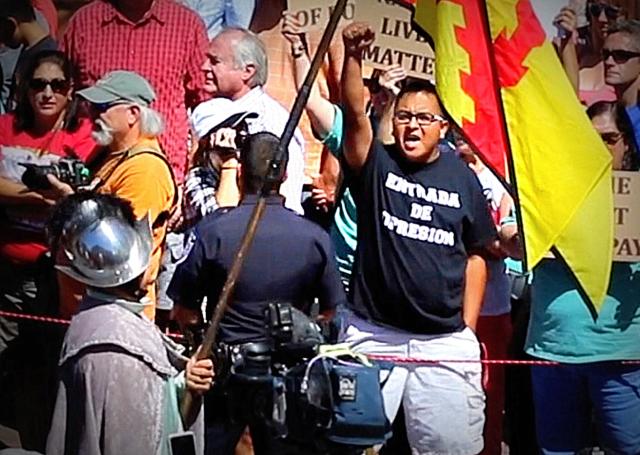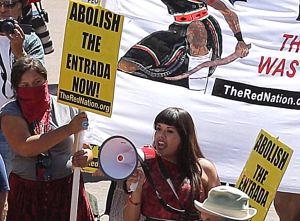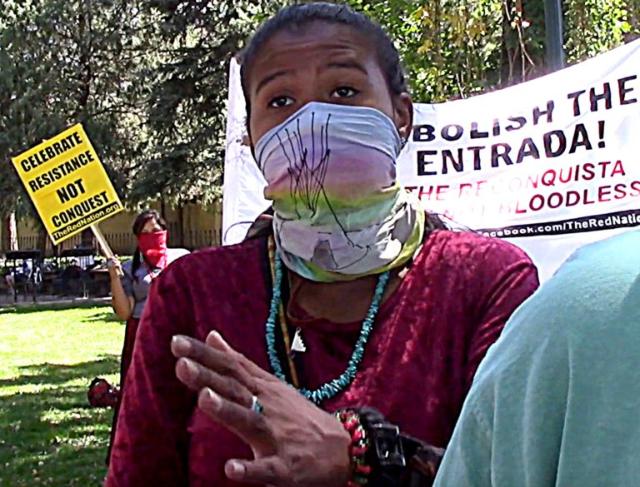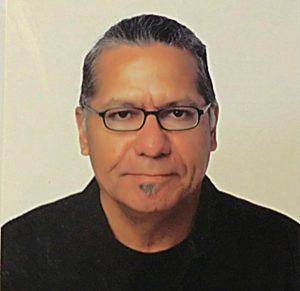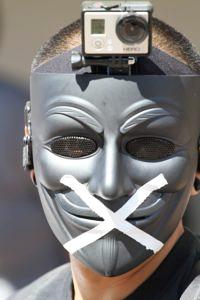 |
Canku Ota
|
 |
|
(Many Paths)
|
||
|
An Online Newsletter
Celebrating Native America
|
||
|
July 2017 - Volume 15
Number 7
|
||
|
|
||
|
Pueblo Revolt Of
1680 Documentary Pressures Santa Fe To Stop Annual Fiesta Entrada
|
||
|
by Frances Madeson -
Indian Country Today
|
||
|
ICMN's own Alex
Jacobs appears in the Pueblo Revolt of 1680 documentary: 'Veiled
Lightning'
There has been a long and troubled history between the Native American residents of Santa Fe and the Santa Fe Fiestas, an annual celebration of the founding of the city. Because Santa Fe has celebrated a watered-down version of a bloody and ugly history against Native people, filmmaker Jaima Chevalier has made a documentary on the Pueblo Revolt of 1680 titled Veiled Lightning to correct what she calls "the lie at the center" of Santa Fe culture.
As part of the Santa Fe Fiestas celebration is an event known as "La Entrada," that is an annual reenactment held in the Santa Fe central plaza depicting the re-taking of the city by Don Diego De Vargas 12 years after the Pueblo Revolt of 1680. However Native American residents of Santa Fe have long protested the city of Santa Fe's unrealistic version of what was a bloody and ugly history. Chevalier, an author of three books about the Southwest who was born and raised in Santa Fe, says she made the Pueblo Revolt of 1680 Veiled Lightning documentary in response to the outrage expressed by Native people and the Santa Fe resistance to embrace the real history. Chevalier would like the Pueblo Revolt of 1680 Veiled Lightning documentary to be used as a vehicle for fostering understanding of the minority viewpoint. "Time did not begin with the arrival of the Spanish, and that the history of the area belongs to all of us. It is only by a reexamination of the Pueblo Revolt of 1680 that we will be able to find a possible reconciliation of the cultural turmoil represented by the sad pageantry of the Entrada."
"This story involves 400 years of history between the Natives and the Spanish, before there was a United States," explained artist, poet and ICMN correspondent Alex Jacobs, who appears onscreen at the 2016 protest interviewing local Natives about their participation.
"[The Entrada] is also a show put on by religious devotees for themselves but also for tourists and tourist money. Many Hispanic city officials also were raised with and performed these re-enactments, but it is only in recent years and with recent generations that Natives have been fighting back with their art, words and reclaiming histories. Neither side is going away on this one," Jacobs told ICMN. In 2015 a group of several dozen protestors attended the Entrada with strips of black tape over their mouths, and held signs that refuted the Fiesta Council's non-violent version of historical events, such as: "In 1693, Don Diego executed 70 warriors and enslaved hundreds of women and children." In 2016 The Red Nation, an inter-tribal activist group based in Albuquerque, along with members of the UNM Kiva Club, joined the protest at the invitation of the Santa Fe Indians. Their numbers swelled and the tape came off; protestors marched and chanted in earshot of those attending the Entrada, and were met by a heavy police presence.
The current mayor, who played Don Diego de Vargas in the 1989 Entrada pageant, is not finding easy solutions to resolving the conflict. Painfully stuck between the rock of tradition and the hard place of adding to Native trauma, the city's main solution has been to enact Indigenous People's Day. Both the mayor and Dean A. Milligan, president of the Fiesta Council, acknowledge the right of the protestors to demonstrate. "We are aware of it, we don't discourage it," said Milligan, "as long as it doesn't get out of control. Last year The Red Nation came in to protest. They used megaphones, which scared the horses and young kids." Milligan said that after last year's protest he looked at photographs of the protestors and found that "very few protesters are from the city of Santa Fe." He questions their motives. "They've been all over the nation protesting," he said. "I don't know if they're paid to do it." Elena Ortiz of Ohkay Owingeh, a longtime Santa Fe resident and organizer of the protests, refuted the rumor. "We were not paid to protest," Ortiz said. "On the contrary, many of us took days off of work, and I personally paid $300 from my own funds for shirts and signs, which were printed by my old friends at Tees and Skis, at cost."
Santa Feans got a chance to view a shortened version of the Pueblo Revolt of 1680 Veiled Lightning documentary at the New Mexico Museum of History on Friday, June 2, It has been entered for screenings for film festivals at SWAIA Class X, Gallup, Pueblo, Imaginative (Toronto), and the Santa Fe Independent Film Festival. The film, which has a Native production team, was awarded silver laurels in the 2017 International Independent Film Awards. For more information visit www.veiledlightning.com. |
|||||||||||||
|
|
|
|
||
|
|
||
| Canku Ota is a free Newsletter celebrating Native America, its traditions and accomplishments . We do not provide subscriber or visitor names to anyone. Some articles presented in Canku Ota may contain copyright material. We have received appropriate permissions for republishing any articles. Material appearing here is distributed without profit or monetary gain to those who have expressed an interest. This is in accordance with Title 17 U.S.C. Section 107. | ||
|
Canku Ota is a copyright ©
2000 - 2017 of Vicki Williams Barry and Paul Barry.
|
||
 |
 |
|
|
The "Canku
Ota - A Newsletter Celebrating Native America" web site and
its design is the
|
||
|
Copyright ©
1999 - 2017 of Paul C. Barry.
|
||
|
All Rights Reserved.
|
||
